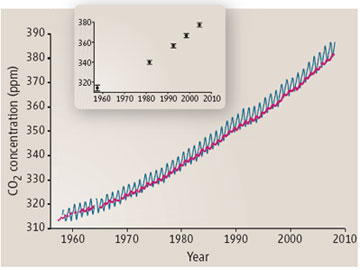Scientists mark 50th Anniversary of the Keeling Curve
Scientists mark 50th Anniversary of the Keeling Curve
Rhett A Butler, mongabay.com
March 27, 2008
|
|
The Keeling Curve, the longest continuous record of atmospheric carbon dioxide levels based on measurements taken atop Hawaii’s Mauna Loa, is now 50 years old. The record provided the first compelling evidence that atmospheric CO2 levels have been rising since the mid-20th century.
Initiated Charles D. Keeling of the Scripps Institution of Oceanography in 1958, the curve shows a steady increase in mean atmospheric CO2 concentration from about 315 parts per million in 1958 to over 380 ppm by the year 2006.
The Keeling Curve “has become an icon of the human imprint on the planet and a continuing resource for the study of the changing global carbon cycle,” writes Ralph Keeling, Charles D. Keeling’s son, in an editorial published this week in the journal Science. “The Mauna Loa story provides a valuable lesson on the importance of continuous Earth observations in a time of accelerating global change.”
 “The value of continuous data. Within a few years, the continuous Mauna Loa (blue) and South Pole (red) records provided convincing evidence that CO2 was rising. If CO2 had been measured only as often as surveys of the North Atlantic overturning circulation, it would have taken decades to obtain convincing evidence,” writes Ralph Keeling. Image courtesy of Science. |
The Mauna Loa story to which Ralph Keeling refers is his father’s ongoing fight for funding for the operation to measure atmospheric CO2 levels. Ralph Keeling writes that without his father’s perseverance in working to convince funders and scientists that the effort as more than “routine monitoring”, the Mauna Loa Observatory may well have shut down in the 1960s like the South Pole monitoring project.
Ralph Keeling says that continued monitoring is key to future scientific progress.
“A continuing challenge to long-term Earth observations is the prejudice against science that is not directly aimed at hypothesis testing. At a time when the planet is being propelled by human action into another climate regime with incalculable social and environmental costs, we cannot afford such a rigid view of the scientific
enterprise,” he writes. “The only way to figure out what is happening to our planet is to measure it, and this means tracking changes decade after decade and poring over the records.”